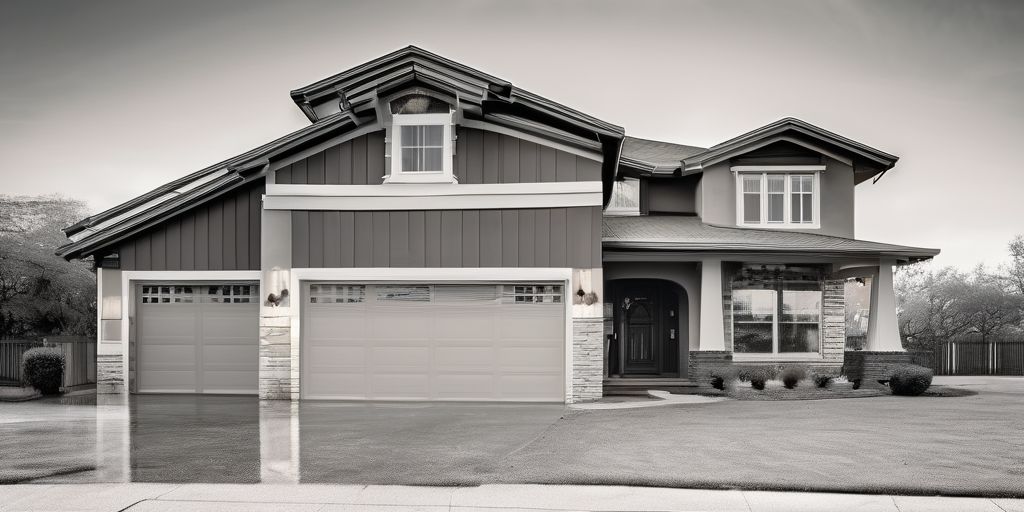Spray painting is a versatile and efficient method for applying coatings to various surfaces, and choosing the right equipment is crucial for achieving a professional finish. This article explores the selection of spray painting equipment in Brantford, offering insights into the basics of equipment, preparation techniques, advanced tools, troubleshooting, and finding a reliable supplier. Whether you’re a seasoned professional or new to the field, understanding these aspects will help you make informed decisions for your spray painting projects.
Key Takeaways
- Knowledge of different types of spray guns and their suitability for specific projects is essential for optimal spray painting results.
- Regular maintenance of spray painting equipment is crucial for its longevity and consistent performance.
- Proper preparation of surfaces and the spray booth, including cleaning, sanding, and mixing paints, is key to achieving a high-quality finish.
- Staying informed about advanced tools and technologies can enhance efficiency and quality in spray painting applications.
- Selecting a reliable equipment supplier in Brantford involves considering factors such as quality, service, support, and the potential for long-term partnerships.
Understanding the Basics of Spray Painting Equipment
Types of Spray Guns: Choosing the Best for Your Project
Selecting the right type of spray gun is crucial for achieving a professional finish. There are primarily three types of spray guns to consider: airless, HVLP (high-volume, low-pressure), and compressed (also known as pneumatic). Each type has its own set of advantages and is suited for different kinds of projects.
- Airless spray guns are known for their ability to handle thicker paints and cover large areas quickly. They work by pumping paint at high pressure, through a small tip, without the use of air.
- HVLP spray guns are more suitable for precision work and are known for their efficiency in paint usage. They operate at lower pressures, which reduces overspray and waste.
- Compressed air spray guns require an air compressor and are versatile, but they can be less efficient in terms of paint usage compared to HVLP models.
When choosing a spray gun, consider the type of paint you’ll be using, the surface you’ll be working on, and the level of detail required for your project.
Maintenance is also a key factor; regular cleaning and proper storage will extend the life of your equipment. Safety gear, including masks and gloves, is essential to protect yourself from harmful fumes and overspray. If you’re in the Brantford area, the Grand River might offer a scenic backdrop for outdoor spray painting projects, but always ensure you’re following local environmental regulations.
The Importance of Proper Equipment Maintenance
Maintaining your spray painting equipment is essential for ensuring its longevity and performance. Regular checks and cleanings can prevent many common issues that arise with spray painting tools. Here are some key maintenance tips:
- Inspect your spray guns and hoses for any signs of wear or damage.
- Clean filters and nozzles to prevent clogs and ensure a consistent spray pattern.
- Lubricate moving parts to reduce friction and prevent corrosion.
Proper maintenance not only extends the life of your equipment but also guarantees the quality of your paint job.
In Brantford, where local weather conditions can affect painting projects, it’s particularly important to keep equipment in top shape. For instance, during the humid summer months, extra attention should be given to preventing rust and corrosion. By following a maintenance schedule, you can avoid unexpected equipment failures and downtime.
Essential Safety Gear for Spray Painting
When engaging in spray painting, it’s crucial to prioritize safety. Proper protective gear is not just a recommendation; it’s a necessity to ensure a safe and successful project. Here’s a list of essential safety items you should always have on hand:
- Safety glasses or goggles to protect your eyes from harmful overspray and debris.
- Respiratory protection, such as a respirator, to guard against inhaling toxic fumes.
- Durable gloves, preferably those that resist solvents, to keep your hands safe from chemicals and paint.
- Protective clothing, like coveralls, to shield your skin and clothes from paint splatters.
- Steel-toe boots to protect your feet from heavy objects and spills.
Familiarize yourself with equipment and follow safety guidelines for a successful project.
While not equipment per se, proper ventilation is also critical to maintain a safe breathing environment. Whether you’re working in a professional spray booth or a makeshift area, ensuring that there’s adequate airflow can greatly reduce the risk of inhaling hazardous substances. If you’re spray painting near Brantford’s Grand River, remember to respect the natural environment by preventing any paint from contaminating the water.
Preparation Techniques for Optimal Results
Surface Cleaning and Sandblasting Basics
Before applying a fresh coat of paint, it’s crucial to prepare the surface meticulously. Effective surface cleaning is not just about aesthetics; it ensures the paint adheres properly and lasts longer. For metal surfaces, such as aluminum siding in Brantford, pressure washing is a common preparation technique. It’s essential to use the right pressure settings to avoid damaging the material.
Sandblasting is another key preparation method, especially for removing rust and old paint. It involves propelling abrasive material against the surface under high pressure. While it’s highly efficient, it requires careful handling to ensure a uniform finish and to prevent surface pitting.
When preparing for spray painting, consider the following steps:
- Set up the equipment according to the manufacturer’s instructions.
- Protect surrounding areas to prevent damage from overspray or sandblasting media.
- Wear the appropriate safety gear, including masks and goggles, to protect against inhaling dust and debris.
In the context of Brantford, where historical landmarks like the Bell Homestead National Historic Site stand as a testament to meticulous care and preservation, the same level of attention to detail is necessary when preparing surfaces for painting. Mastering these techniques will lead to professional results and durable finishes.
Mixing Paints and Coatings: A Step-by-Step Guide
Mixing paints and coatings correctly is crucial for achieving a professional finish. Consistency is key; it ensures that the paint is applied evenly and dries uniformly. Here’s a simple guide to help you mix your materials properly:
- Start by selecting the appropriate thinner or solvent for your paint or coating. This will depend on the type of paint and the desired viscosity.
- Measure the paint and thinner accurately, using separate containers for each. Precision is important to maintain the correct ratios.
- Pour the thinner into the paint while stirring continuously. This helps to avoid lumps and ensures a smooth mixture.
- Mix thoroughly until you achieve a uniform consistency. Use a mixing stick or a mechanical mixer if available.
- Test the mixture on a small, inconspicuous area to ensure it’s ready for application.
It’s essential to mix in a well-ventilated area to avoid inhaling fumes, and always wear the appropriate safety gear.
Remember to clean your equipment immediately after use to prevent the paint from hardening and causing future problems. With these steps, you’ll be ready to spray paint with confidence, whether you’re working on a project in your garage or tackling a larger job in Brantford, where the Grand River adds a picturesque backdrop to many outdoor painting projects.
Setting Up Your Spray Booth: Tips and Tricks
Setting up your spray booth correctly is crucial for achieving professional results and maintaining a safe work environment. Here are some tips and tricks to ensure your setup is optimal:
- Ensure proper ventilation to avoid the buildup of fumes and to maintain a clean air supply.
- Position lighting strategically to eliminate shadows and provide even illumination across your work area.
- Implement a routine for checking and replacing filters regularly to maintain air quality.
When configuring your spray booth, it’s important to consider the workflow. Arrange your equipment and materials for easy access and efficient movement.
- Use non-slip flooring materials to enhance safety.
- Establish a maintenance schedule for your equipment to prevent malfunctions.
While these tips are universally applicable, if you’re setting up a booth in the Brantford area, take advantage of the region’s climate to optimize your drying times. Remember, consistency in your setup will lead to consistent results in your spray painting projects.
Advanced Spray Painting Tools and Technology
Innovative Spray Systems for Enhanced Efficiency
In the realm of professional spray painting, efficiency is key. Innovative spray systems have been developed to significantly reduce the time and effort required for large-scale projects. These systems often incorporate advanced features such as:
- Automated paint mixing and delivery
- Precision control mechanisms
- Self-cleaning nozzles
Italics are used to emphasize the importance of precision in achieving a flawless finish. The integration of these features into spray systems enhances not only the efficiency but also the consistency of the paint application process.
The adoption of innovative spray systems can lead to a marked improvement in productivity, which is especially beneficial for professional painting companies tackling extensive exterior projects.
While these advancements are impressive, it’s crucial to ensure that the equipment is compatible with the specific requirements of the task at hand. Factors such as the type of paint, the surface to be coated, and the desired finish must all be considered when selecting a spray system. In Brantford, where the weather can influence painting conditions, it’s also important to consider the impact of temperature and humidity on the equipment’s performance.
Automated vs. Hand-Held Spray Equipment
When selecting spray painting equipment, it’s crucial to understand the differences between automated and hand-held systems. Automated spray equipment is designed for large-scale projects and offers consistent coverage and speed. In contrast, hand-held spray guns are more suitable for detailed work and smaller jobs.
- Automated Systems:
- High efficiency
- Uniform application
- Ideal for repetitive tasks
- Hand-Held Guns:
- Greater control
- Flexibility in movement
- Perfect for custom work
While automated systems can significantly increase productivity, hand-held equipment allows for a more personalized approach to spray painting.
Choosing between the two types of equipment depends on the specific needs of your project. For instance, the comparison of roller and spray painting techniques for aluminum siding in St. Catharines shows that spray painting can provide a faster, professional finish, which is something to consider when efficiency is key. On the other hand, for those seeking professional-level spray painting in Niagara Falls, the choice of equipment will greatly influence the final results. Similarly, selecting the right spray painting gear in Milton is essential for achieving high-quality finishes and efficient operation.
The Role of Test Equipment in Ensuring Quality
In the realm of spray painting, the quality of the final product is heavily dependent on the precision and reliability of the test equipment used. Test equipment is vital for verifying the consistency and quality of paint application before full-scale production commences. This equipment ranges from viscosity cups for measuring paint thickness to gloss meters that assess the shine of the finished surface.
Test equipment also plays a crucial role in ensuring that spray painting systems are calibrated correctly and operating at optimal performance. Regular testing can help identify potential issues early, allowing for timely adjustments and maintenance. This proactive approach to quality control helps to avoid costly rework and ensures that the final product meets the required standards.
- Viscosity cups
- Gloss meters
- Calibration tools
- Performance monitors
By integrating test equipment into the spray painting process, operators can achieve a high level of precision, which is essential for delivering a product that stands up to scrutiny and satisfies customer expectations.
Troubleshooting Common Spray Painting Issues
Dealing with Clogs and Inconsistent Spray Patterns
Clogs and inconsistent spray patterns can be a significant hindrance to achieving a flawless finish. Regular cleaning and maintenance of your spray equipment are essential to prevent these issues. Here are some steps to help you maintain a consistent spray pattern and avoid clogs:
- Inspect your equipment before each use for any signs of wear or damage.
- Clean all parts thoroughly after use, especially the nozzle and filter, to remove any residual paint.
- Use the appropriate thinner or solvent for cleaning, as specified by the equipment manufacturer.
In the event of a clog, follow these guidelines:
- Disconnect the spray gun from the power source.
- Dismantle the gun and soak the affected parts in the recommended cleaning solution.
- Use a soft brush or a specialized cleaning tool to gently remove the clog.
- Reassemble the gun and test it to ensure it is functioning correctly.
It’s important to address clogs promptly to maintain the quality of your work and extend the life of your equipment.
If you’re experiencing inconsistent spray patterns, consider the following:
- Check the paint viscosity and adjust it according to the manufacturer’s recommendations.
- Ensure the air pressure is set correctly for the type of paint you’re using.
- Practice your technique to maintain a consistent distance and speed while spraying.
By following these tips, you can help ensure that your spray painting equipment operates smoothly, leading to better results and a more efficient painting process.
Temperature and Humidity: Managing Environmental Factors
When it comes to spray painting, environmental factors such as temperature and humidity play a pivotal role in the quality of the finish. Weather impacts painting outcomes, and it’s essential for an exterior painter to consider these elements carefully to ensure a successful project.
- Temperature: Paint should not be applied in extreme temperatures. Ideal conditions are typically between 50-80 degrees Fahrenheit.
- Humidity: High humidity can prevent paint from drying properly. Aim for a relative humidity between 40-50% for optimal results.
In Brantford, where weather can be unpredictable, monitoring these conditions is crucial for maintaining the integrity of your work.
Adjusting your schedule to paint during the most suitable weather conditions can make a significant difference in the final outcome. Preparation in less visible areas enhances technique, and organized tools improve safety and creativity. Always check the forecast and plan accordingly to avoid any weather-related issues.
Quick Fixes for Equipment Malfunctions
When dealing with equipment malfunctions during spray painting, a few quick fixes can save time and prevent further issues. Always start by consulting the equipment’s manual for specific troubleshooting tips. If you encounter a problem, here are some general steps to consider:
- Check for obvious signs of damage or wear and tear on your spray painting equipment. Replace any worn parts as needed.
- Ensure all connections are secure and there are no leaks in the air or paint lines.
- Clean the spray gun thoroughly, paying special attention to the nozzle and filter to remove any clogs.
If the issue persists, it may be necessary to perform a more in-depth inspection and possibly seek professional repair. However, for minor issues, these steps can often get you back to work quickly.
In the event of a malfunction, it’s essential to maintain a calm and methodical approach to diagnosing and fixing the problem.
For those in the Brantford area, a visit to the Grand River might offer a peaceful break while waiting for equipment to dry or after completing repairs.
Selecting a Reliable Equipment Supplier in Brantford
Criteria for Choosing a Supplier: Quality, Service, and Support
When selecting a supplier for spray painting equipment, it’s crucial to evaluate their offerings based on three key criteria: quality, service, and support. Quality should be non-negotiable; the equipment must meet industry standards and be durable enough to withstand the demands of your specific projects. Service is equally important; a supplier should provide comprehensive services that cover all aspects of spray painting, from initial consultation to after-sales support. Lastly, support encompasses both technical assistance and the availability of spare parts, ensuring minimal downtime in case of equipment malfunctions.
- Quality of equipment
- Range of services offered
- Level of technical support
It’s advisable to choose a supplier with a diverse project experience, as they are more likely to understand the unique challenges of different spray painting applications. Additionally, positive customer reviews can be a good indicator of a supplier’s reliability and commitment to customer satisfaction. While considering these factors, also think about the supplier’s approach to sustainability, such as offering eco-friendly paints, which can contribute to a more sustainable practice.
When evaluating suppliers, consider their commitment to environmental responsibility and the use of eco-friendly products.
If you’re based in Brantford, it may be beneficial to consider local suppliers who understand the regional market and can provide tailored advice. For instance, a supplier familiar with the challenges of outdoor vinyl siding painting in Brantford’s climate would be invaluable.
Local Suppliers vs. Global Manufacturers: Pros and Cons
When selecting equipment for spray painting, the choice between local suppliers and global manufacturers is crucial. Local suppliers may offer personalized service and quicker response times. They often have a better understanding of the Brantford area’s specific needs, such as the consideration of seasonal temperature variations for brick painting projects.
Global manufacturers, on the other hand, might provide a wider range of products and potentially lower costs due to economies of scale. However, they may lack the local touch and could have longer lead times for delivery and service.
- Pros of Local Suppliers:
- Personalized service
- Quick response times
- Local market knowledge
- Pros of Global Manufacturers:
- Broader product range
- Potential cost savings
It’s essential to weigh these factors against your project requirements and preferences to make the best decision for your spray painting needs in Brantford.
Building Long-Term Partnerships for Sustainable Success
Establishing enduring partnerships with equipment suppliers is not just about the immediate transaction; it’s about building a relationship that will foster continuous improvement and support over time. Here are some key considerations for creating sustainable partnerships:
- Mutual understanding of business goals and values.
- Commitment to quality and reliability in both products and service.
- Open communication channels for feedback and problem-solving.
- Flexibility to adapt to changing needs and market conditions.
When selecting a supplier, consider how they align with your long-term objectives and their willingness to collaborate on future projects.
In Brantford, the commitment to sustainability can be seen in the way local businesses maintain the city’s historic appeal. For instance, external brick painting is not only about aesthetics but also about preserving the architectural heritage, which resonates with the city’s charm and community values.
- Evaluation of supplier’s track record and reputation.
- Ensuring the supplier has a robust support system for maintenance and emergencies.
By focusing on these aspects, businesses can ensure that their partnerships are built on a solid foundation of trust and shared objectives, leading to long-term success and growth.
When it comes to selecting a reliable equipment supplier in Brantford, it’s essential to choose a partner that understands your needs and can provide high-quality solutions. At We Paint Siding, we pride ourselves on our expertise in reviving home exteriors with professional finishes that last. Our services are not only cost-efficient but also backed by a 10-Year Guarantee. Don’t settle for less; enhance your home’s curb appeal with our specialized services. Visit our website to explore our gallery of beautifully painted houses and book your free estimate today. Let us transform your home’s exterior into a dreamy reality.
Conclusion
Selecting the right equipment for spray painting is crucial for achieving professional results, especially in a city like Brantford where the demand for skilled industrial painting and equipment maintenance is on the rise. Whether you’re a seasoned industrial painter, a welder/fitter, or a general laborer, understanding the importance of using quality tools and materials cannot be overstated. By fostering relationships with leading manufacturers and staying informed about the latest innovations, you can ensure that the integrity of your work stands the test of time. Remember, the right equipment not only enhances efficiency but also reflects the quality of service you provide to your clients. As we’ve explored throughout this article, making informed decisions will help you excel in your craft and contribute to the growth and success of your business in Brantford’s thriving industrial sector.
Frequently Asked Questions
What types of spray guns are available and how do I choose the best one for my project in Brantford?
There are several types of spray guns, including HVLP (High Volume Low Pressure), LVLP (Low Volume Low Pressure), airless, and electrostatic spray guns. The best choice depends on the specific requirements of your project, such as the type of paint or coating being used, the precision needed, and the surface being painted. For detailed projects in Brantford, HVLP guns are often preferred for their precision and reduced overspray.
Why is equipment maintenance essential for spray painting?
Proper maintenance of spray painting equipment is crucial to ensure consistent paint application, prevent clogs and breakdowns, and extend the lifespan of the equipment. Regular cleaning, inspection, and replacement of worn parts can significantly improve the performance and reliability of your spray painting tools.
What safety gear is necessary for spray painting?
Essential safety gear for spray painting includes respirators or masks to protect against fumes, goggles or face shields to protect your eyes, gloves to protect your hands from chemicals, and appropriate clothing to cover exposed skin. It’s also important to ensure proper ventilation in your spray painting area.
How do I prepare surfaces for spray painting to achieve optimal results?
Surface preparation is key to achieving a high-quality finish. This includes cleaning the surface to remove dirt, grease, and rust, sandblasting to create a smooth base, and ensuring the area is free of contaminants. Proper mixing of paints and setting up a clean, controlled environment like a spray booth are also important steps.
What advanced tools and technologies are available for spray painting in Brantford?
Advanced tools and technologies for spray painting include automated spray systems, which can increase efficiency and uniformity of paint application, and specialized test equipment to ensure the quality of the finish. Brantford suppliers may offer innovative solutions tailored to your specific needs.
How do I choose a reliable equipment supplier in Brantford for my spray painting needs?
When selecting a supplier in Brantford, consider factors such as the quality of the products offered, the level of customer service and support, and the supplier’s ability to provide value-added solutions. It’s also beneficial to establish a long-term partnership with a supplier that understands your business and industry requirements.





